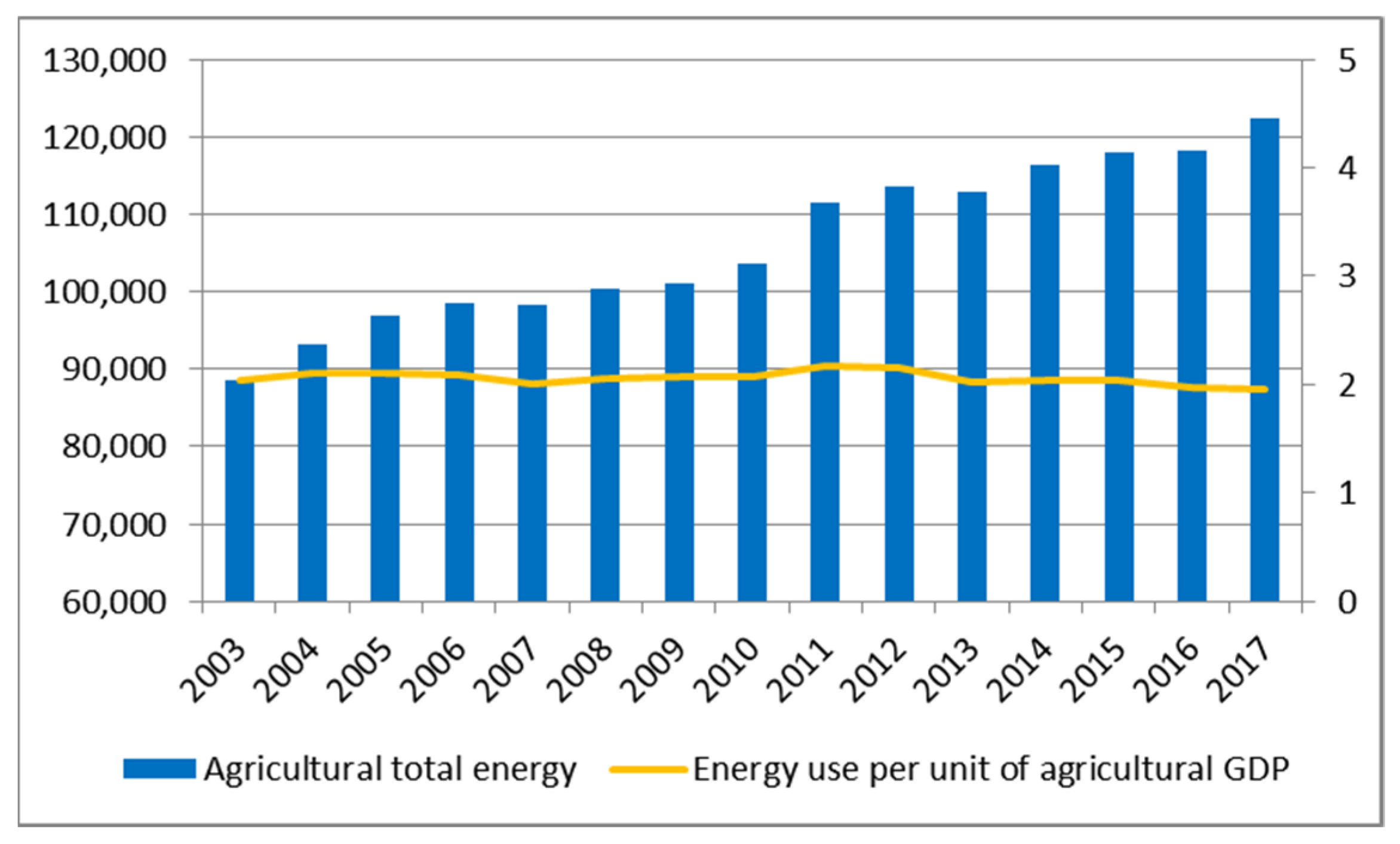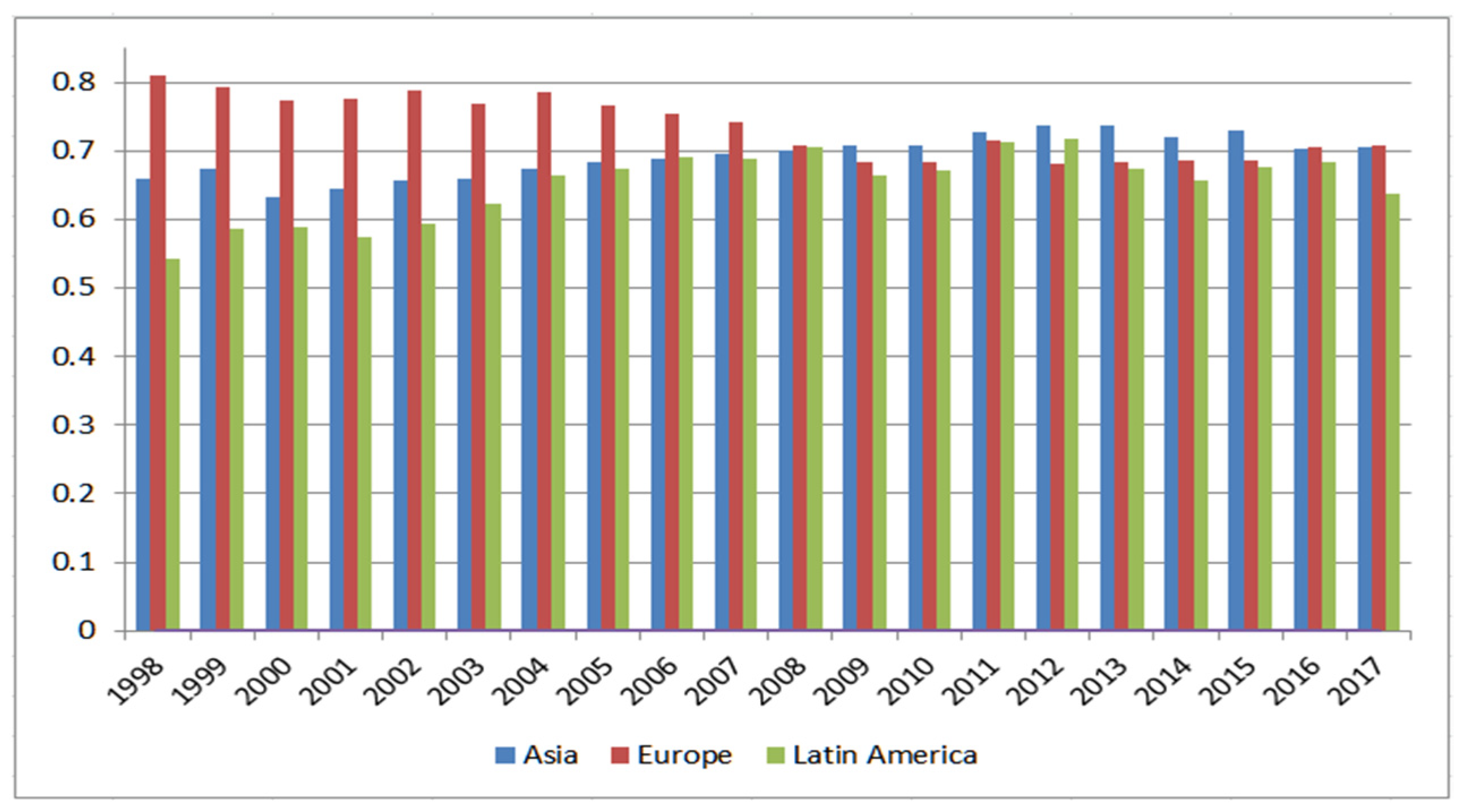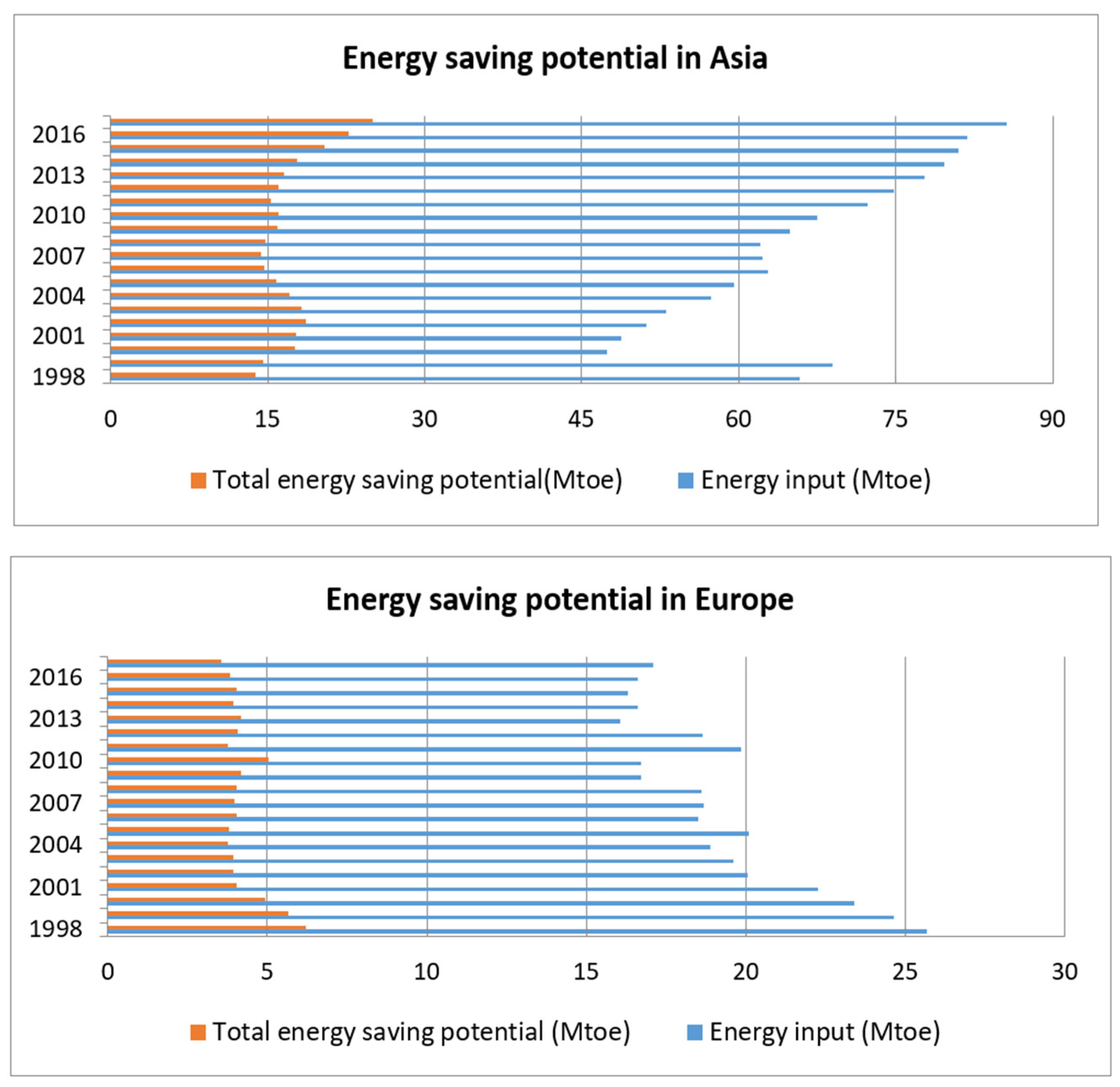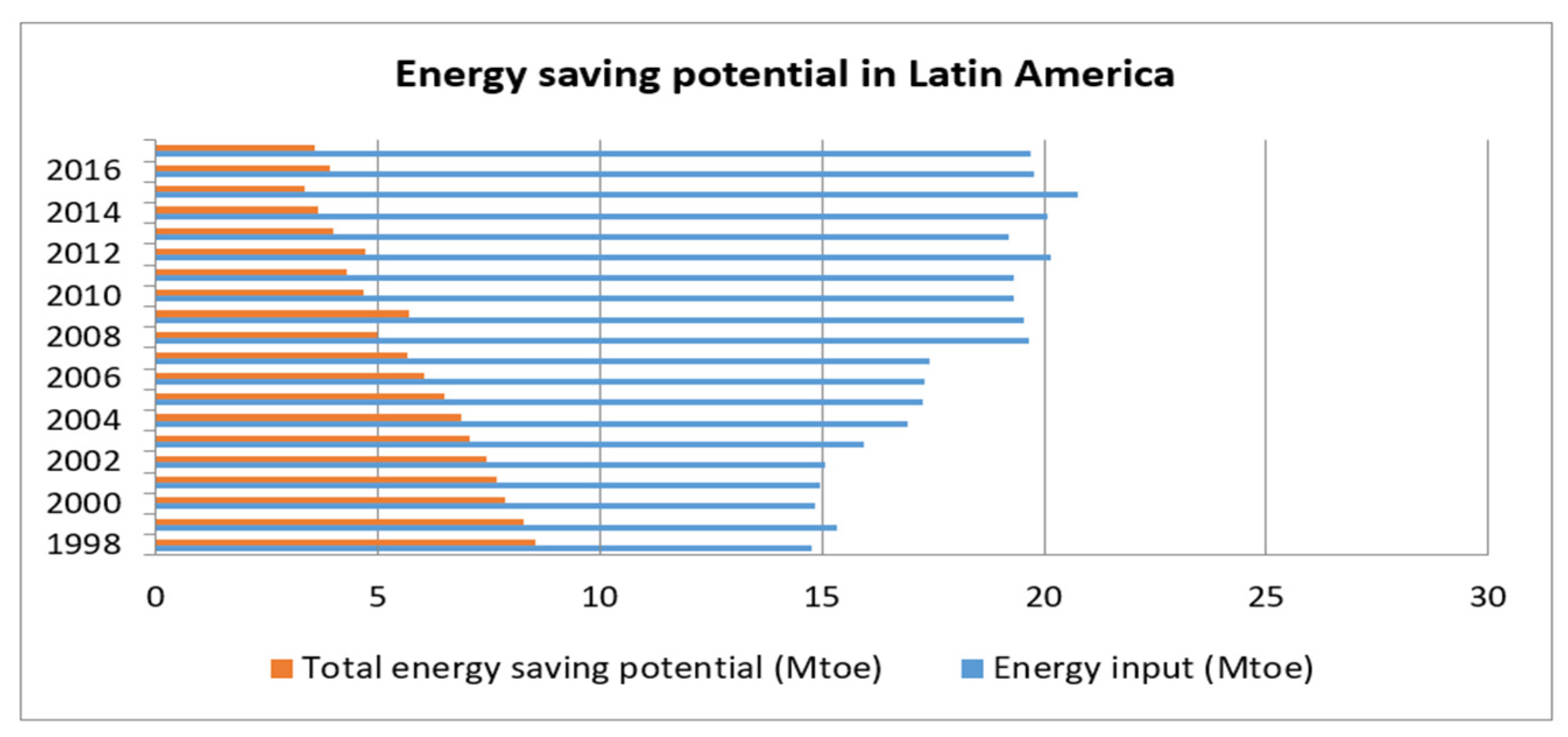Energy Efficiency, Energy Conservation and Determinants in the Agricultural Sector in Emerging Economies
Abstract
1. Introduction
2. Methodology
3. Variables
4. Empirical Results
4.1. SFA Model Results
4.2. Energy Efficiency in Emerging Economies’ Agricultural Sector
4.3. Analysis of National Differences
4.4. Energy-Saving Potential in Emerging Economies’ Agricultural Sector
4.5. Factor Analysis for Agricultural Energy Efficiency (AEE)
5. Conclusions and Policy Implications
Author Contributions
Funding
Institutional Review Board Statement
Informed Consent Statement
Data Availability Statement
Acknowledgments
Conflicts of Interest
References
- Prasetyo, P.E.; Kistanti, N.R. Human capital, institutional economics and entrepreneurship as a driver for quality & sustainable economic growth. Entrep. Sustain. Issues 2020, 7, 2575–2589. [Google Scholar]
- Ozturk, I. Measuring the impact of energy consumption and air quality indicators on climate change: Evidence from the panel of UNFCC classified countries. Environ. Sci. Pollut. Res. 2015, 22, 15459–15468. [Google Scholar] [CrossRef]
- Francesco, N.T.; Mirella, S.; Simone, R.; Alessandro, F.; Nuala, F.; Pete, S. The FAOSTAT database of greenhouse gas emissions from agriculture. Environ. Res. Lett. 2013, 8, 015009. [Google Scholar]
- Huang, W.T.; Chien, C.Y. Patterns and Factors of Farming Innovation in Taiwan. J. Agric. Sci. 2013, 5, 269–279. [Google Scholar] [CrossRef][Green Version]
- Bayar, Y.; Gavriletea, M.D. Energy efficiency, renewable energy, economic growth: Evidence from emerging market economies. Qual. Quant. Int. J. Methodol. 2019, 53, 2221–2234. [Google Scholar] [CrossRef]
- Fei, R.; Lin, B. Energy efficiency and production technology heterogeneity in China’s agricultural sector: A meta-frontier approach. Technol. Forecast. Soc. 2016, 109, 25–34. [Google Scholar] [CrossRef]
- Tripathi, A.; Prasad, A.R. Agricultural Development in India since Independence: A Study on Progress, Performance, and Determinants. J. Emerg. Knowl. Emerg. Mark. 2009, 1, 63–92. [Google Scholar] [CrossRef]
- VanLoon, G.W.; Patil, S.G.; Hugar, L.B. Agricultural Sustainability: Strategies for Assessment; SAGE: New Delhi, India, 2005. [Google Scholar]
- Han, H.; Wu, S. Structural Change and Its Impact on the Energy Intensity of Agricultural Sector in China. Sustainability 2018, 10, 4591. [Google Scholar] [CrossRef]
- Cardozo, N.P.; de Oliveira Bordonal, R.; La Scala, N. Sustainable intensification of sugarcane production under irrigation systems, considering climate interactions and agricultural efficiency. J. Clean. Prod. 2018, 204, 861–871. [Google Scholar] [CrossRef]
- Bručienė, I.; Aleliūnas, D.; Šarauskis, E.; Romaneckas, K. Influence of Mechanical and Intelligent Robotic Weed Control Methods on Energy Efficiency and Environment in Organic Sugar Beet Production. Agriculture 2021, 11, 449. [Google Scholar] [CrossRef]
- Dyer, J.A.; Desjardins, R.L. Energy use and fossil CO2 emissions for the Canadian fruit and vegetable industries. Energy Sustain. Dev. 2018, 47, 23–33. [Google Scholar] [CrossRef]
- Jat, H.S.; Jat, R.D.; Nanwal, R.K.; Lohan, S.K.; Yadav, A.K.; Poonia, T.; Sharma, P.C.; Jat, M.L. Energy use efficiency of crop residue management for sustainable energy and agriculture conservation in NW India. Renew Energy 2020, 155, 1372–1382. [Google Scholar] [CrossRef]
- Yang, Z.; Wang, D.; Du, T.; Zhang, A.; Zhou, Y. Total-factor energy efficiency in China’s agricultural sector: Trends, disparities and potentials. Energies 2018, 11, 853. [Google Scholar] [CrossRef]
- Vlontzos, G.; Niavis, S.; Manos, B. A DEA approach for estimating the agricultural energy and environmental efficiency of EU countries. Renew. Sustain. Energy Rev. 2014, 40, 91–96. [Google Scholar] [CrossRef]
- Li, C.; Wang, H.; Miao, H.; Ye, B. The economic and social performance of integrated photovoltaic and agricultural greenhouses systems: Case study in China. Appl. Energy 2017, 190, 204–212. [Google Scholar] [CrossRef]
- Rahman, S.; Rahman, M.S.; Rahman, M.H. Joint determination of the choice of growing season and economic efficiency of maize in Bangladesh. J. Asia Pac. Econ. 2012, 17, 138–150. [Google Scholar] [CrossRef]
- Rahman, S.; Hasan, M.K. Energy productivity and efficiency of wheat farming in Bangladesh. Energy 2014, 66, 107–114. [Google Scholar] [CrossRef]
- Wysokiński, M.; Domagała, J.; Gromada, A.; Golonko, M.; Trębska, P. Economic and energy efficiency of agriculture. Agric. Econ. 2020, 66, 355–364. [Google Scholar] [CrossRef]
- Ozcan, B.; Ozturk, I. Renewable energy consumption-economic growth nexus in emerging countries: A bootstrap panel causality test. Renew. Sustain. Energy Rev. 2019, 104, 30–37. [Google Scholar] [CrossRef]
- Hatirli, S.A.; Ozkan, B.; Fert, C. An econometric analysis of energy input-output in Turkish agriculture. Renew Sustain. Energy Rev. 2005, 9, 608–623. [Google Scholar] [CrossRef]
- Wen, L.; Li, H. Estimation of agricultural energy efficiency in five provinces: Based on data envelopment analysis and Malmquist index model. Energy Source Part A 2019, 41, 1–14. [Google Scholar] [CrossRef]
- Wang, C.; Siriwardana, M.; Meng, S. Effects of the Chinese arable land fallow system and land-use change on agricultural production and on the economy. Econ. Model. 2019, 79, 186–197. [Google Scholar] [CrossRef]
- Patterson, M.G.; Makarov, V.I.; Khmelinskii, I.V. What is energy efficiency? Concepts, indicators, and methodological issues. Energy Policy 1996, 5, 377–390. [Google Scholar] [CrossRef]
- Wei, C.; Shen, M. Energy Efficiency and Energy Productivity: A Comparison of based on the Panel Data by Province. J. Quant. Tech. Econ. 2007, 9, 110–121. [Google Scholar]
- Hu, J.; Wang, S. Total factor energy efficiency of regions in China. Energy Policy 2006, 34, 3206–3217. [Google Scholar] [CrossRef]
- Lin, B.; Wang, X. Exploring energy efficiency in China’s iron and steel industry: A stochastic frontier approach. Energy Policy 2014, 72, 87–96. [Google Scholar] [CrossRef]
- Wei, Z.; Han, B.; Pan, X.; Shahbaz, M.; Zafar, M.W. Effects of diversified openness channels on the total-factor energy efficiency in China’s manufacturing sub-sectors: Evidence from trade and FDI spillovers. Energy Econ. 2020, 90, 104836. [Google Scholar] [CrossRef]
- Coelli, T.J. Recent Development in Frontier Modeling and Efficiency Measurement. Aust. J. Agric. Econ. 1995, 39, 219–245. [Google Scholar]
- Alluvione, F.; Moretti, B.; Sacco, D.; Grignani, C. Energy use efficiency of cropping systems for a sustainable agriculture. Energy 2011, 36, 4468–4481. [Google Scholar] [CrossRef]
- Noguchi, R.; Saito, T. Consideration of energy consumption and energy efficiency in mechanized rice production system by using inventory analysis. Agric. Infor. Res. 2008, 17, 20–30. [Google Scholar] [CrossRef][Green Version]
- Chang, C.L.; Oxley, L. Industrial agglomeration, geographic innovation and total factor productivity: The case of Taiwan. Math. Comput. Simulat. 2009, 79, 2787–2796. [Google Scholar] [CrossRef]
- Liu, J.; Cheng, Z.; Zhang, H. Does industrial agglomeration promote the increase of energy efficiency in China? J. Clean. Prod. 2017, 164, 30–37. [Google Scholar] [CrossRef]
- Martínez, F.B.; Guevara, F.; Aguilar, C.E.; Pinto, R.; La O, M.A.; Rodríguez, L.A.; Aryal, D.R. Energy and Economic Efficiency of Maize Agroecosystem under Three Management Strategies in the Frailesca, Chiapas (Mexico). Agriculture 2020, 10, 81. [Google Scholar] [CrossRef]
- Haider, S.; Bhat, A.J. Inter-state analysis of energy efficiency—A stochastic frontier approach to the Indian paper industry. Int. J. Energy Serv. Manag. 2018, 12, 547–565. [Google Scholar] [CrossRef]
- Alhamzawi, R.; Mohammad Ali, H.T. Bayesian Tobit quantile regression with penalty. Commun. Stat B-Simul. 2018, 47, 1739–1750. [Google Scholar] [CrossRef]
- Zhou, P.; Ang, B.; Zhou, D. Measuring economy-wide energy efficiency performance: A parametric frontier approach. Appl. Energy 2012, 90, 196–200. [Google Scholar] [CrossRef]
- Wei, Z.; Conlon, E.M.; Wang, T. Asymmetric dependence in the stochastic frontier model using skew normal copula. Int. J. Approx. Reason. 2021, 128, 56–68. [Google Scholar] [CrossRef]
- Bianco, V.; Cascetta, F.; Marino, A.; Nardini, S. Understanding energy consumption and carbon emissions in Europe: A focus on inequality issues. Energy 2019, 170, 120–130. [Google Scholar] [CrossRef]
- Borozan, D. Technical and total factor energy efficiency of European regions: A two-stage approach. Energy 2018, 152, 521–532. [Google Scholar] [CrossRef]
- Fragkos, P.; Tasios, N.; Paroussos, L.; Capros, P.; Tsani, S. Energy system impacts and policy implications of the European Intended Nationally Determined Contribution and low-carbon pathway to 2050. Energy Policy 2017, 100, 216–226. [Google Scholar] [CrossRef]
- Lin, B.; Zhu, J. Energy and carbon intensity in China during the urbanization and industrialization process: A panel VAR approach. J. Clean. Prod. 2017, 168, 780–790. [Google Scholar] [CrossRef]
- Schneider, U.A.; Rasche, L.; McCarl, B.A. Assessing the Economic Impacts of Pesticide Regulations. Agriculture 2018, 8, 53. [Google Scholar] [CrossRef]
- Raheli, H.; Rezaei, R.M.; Jadidi, M.R.; Mobtaker, H.G. A two-stage DEA model to evaluate sustainability and energy efficiency of tomato production. Inf. Process. Agric. 2017, 4, 342–350. [Google Scholar] [CrossRef]
- Lv, Y.; Chen, W.; Cheng, J. Effects of urbanization on energy efficiency in China: New evidence from short run and long run efficiency models. Energy Policy 2020, 147, 111858. [Google Scholar] [CrossRef]
- Zaman, G.; Goschin, Z. Energy Efficiency: Trends and Influence Factors. Rom. J. Econ. 2006, 23, 7–12. [Google Scholar]
- Chen, Z.; Song, S. Efficiency and technology gap in China’s agriculture: A regional meta-frontier analysis. China Econ. Rev. 2008, 19, 287–296. [Google Scholar] [CrossRef]
- Marques, A.C.; Fuinhas, J.A.; Tomas, C. Energy efficiency and sustainable growth in industrial sectors in European Union countries: A nonlinear ARDL approach. J. Clean. Prod. 2019, 239, 118045. [Google Scholar] [CrossRef]
- Smith, L.G.; Williams, A.; Pearce, B. The energy efficiency of organic agriculture: A review. Renew Agric. Food Syst. 2015, 30, 280–301. [Google Scholar] [CrossRef]
- Niavis, S.; Vlontzos, G. Seeking for Convergence in the Agricultural Sector Performance under the Changes of Uruguay Round and 1992 CAP Reform. Sustainability 2019, 11, 4006. [Google Scholar] [CrossRef]
- Deepak, S. Financial and Economic Crisis: Implications for Agricultural Sector in India; MPRA Paper 39274; University Library of Munich: Munich, Germany, 2012. [Google Scholar]
- Viglizzo, E.F.; Frank, C.F. Energy use in agriculture: Argentina compared with other countries. In Energy Consumption: Impacts of Human Activity, Current and Future Challenges, Environmental and Socio-Economic Effects; Reiter, S., Ed.; NOVA Science Publishers: New York, NY, USA, 2014; pp. 77–98. [Google Scholar]
- Pellegrini, P.; Fernández, R.J. Crop intensification, land use, and on-farm energy-use efficiency during the worldwide spread of the green revolution. Proc. Natl. Acad. Sci. USA 2018, 115, 2335–2340. [Google Scholar] [CrossRef] [PubMed]
- Värnik, R.; Aste, R.; Ariva, J. Sustainable Intensification in Crop Farming—A Case from Estonia. In Precision Agriculture: Technology and Economic Perspectives; Pedersen, S.M., Lind, K.M., Eds.; Springer: Singapore, 2017; pp. 201–221. [Google Scholar]
- Zhang, Z.; Zinda, J.A.; Li, W. Forest transitions in Chinese villages: Explaining community-level variation under the returning forest to farmland program. Land Use Policy 2017, 64, 245–257. [Google Scholar] [CrossRef]
- Dutra, L.; Schwinden, N.B.C.; Andrade, S.F.D. Future scenarios and trends in energy generation in Brazil: Supply and demand and mitigation forecasts. J. Clean. Prod. 2015, 103, 197–210. [Google Scholar] [CrossRef]
- Sadorsky, P. Do urbanization and industrialization affect energy intensity in developing countries? Energy Econ. 2013, 37, 52–59. [Google Scholar] [CrossRef]
- Shancita, I.; Masjuki, H.H.; Kalam, M.A.; Fattah, I.M.R.; Rashed, M.M.; Rashedul, H.K. A review on idling reduction strategies to improve fuel economy and reduce exhaust emissions of transport vehicles. Energy Convers. Manag. 2014, 88, 794–807. [Google Scholar] [CrossRef]
- Lechenet, M.; Dessaint, F.; Py, G.; Makowski, D.; Munier-Jolain, N. Reducing pesticide use while preserving crop productivity and profitability on arable farms. Nat. Plants 2017, 3, 17008. [Google Scholar] [CrossRef]
- Deike, S.; Pallutt, B.; Christen, O. Investigations on the energy efficiency of organic and integrated farming with specific emphasis on pesticide use intensity. Eur. J. Agron. 2008, 28, 461–470. [Google Scholar] [CrossRef]
- Chen, S.; Zhang, S. Large-Scale Land Use for Construction and Energy Consumption after the New Millennium with Their Impact on Total-Factor Efficiency Change in China’s Regional Economy. Energies 2014, 7, 1986. [Google Scholar] [CrossRef]




| Variables | Model 1 | Model 2 | Model 3 | Model 4 |
|---|---|---|---|---|
| Constant | 0.466 *** | 1.077 *** | 0.303 *** | 0.231 *** |
| lnY | −0.359 *** | −0.071 *** | 0.134 | 0.322 *** |
| lnK | 0.667 *** | 0.716 *** | 0.579 *** | 0.503 *** |
| lnL | 0.198 *** | 0.048 *** | −0.080 * | −0.292 *** |
| lnY × lnY | −0.355 ** | −0.282 *** | −0.527 *** | −0.558 *** |
| lnK × lnK | 0.244 *** | 0.228 *** | 0.178 *** | 0.098 *** |
| lnL × lnL | 0.009 | 0.034 ** | −0.015 | 0.025 |
| lnY × lnK | 0.087 * | 0.095 *** | 0.244 *** | 0.359 *** |
| lnK × lnL | 0.010 | 0.038 *** | −0.183 *** | −0.322 *** |
| lnY × lnL | 0.010 | −0.074 * | 0.179 ** | 0.270 ** |
| T | −0.071 *** | −0.031 ** | −0.038 *** | |
| T × T | 0.003 *** | 0.001 | 0.002 | |
| T × lnY | −0.029 *** | −0.017 ** | −0.014 * | |
| T × lnK | 0.005 *** | 0.001 | −0.005 | |
| T × lnL | 0.010 *** | 0.009 ** | 0.011 *** | |
| H | 0.622 *** | 0.137 * | ||
| M | 0.346 *** | 0.390 *** | ||
| H × lnY | −1.775 *** | |||
| M × lnY | −0.267 ** | |||
| H × lnK | 0.945 *** | |||
| M × lnK | 0.089 | |||
| H × lnL | 0.721 *** | |||
| M × lnL | 0.270*** | |||
| sigma-squared | 0.667 *** | 0.824 *** | 0.362 *** | 0.303 *** |
| gamma | 0.947 *** | 1.000 *** | 0.780 *** | 0.835 *** |
| log likelihood | −371.91 | −333.86 | −298.73 | −226.14 |
| AIC | 761.82 | 695.72 | 629.46 | 496.28 |
| BIC | 800.44 | 755.80 | 698.13 | 590.69 |
| Asia | Energy Efficiency | Europe | Energy Efficiency | Latin America | Energy Efficiency |
|---|---|---|---|---|---|
| China | 0.723 | Bulgaria | 0.810 | Argentina | 0.754 |
| India | 0.761 | Czech | 0.833 | Brazil | 0.597 |
| Indonesia | 0.430 | Estonia | 0.865 | Colombia | 0.564 |
| Pakistan | 0.494 | Greece | 0.591 | Dominican Rep. | 0.740 |
| South Korea | 0.749 | Hungary | 0.693 | Mexico | 0.747 |
| Thailand | 0.875 | Latvia | 0.641 | Peru | 0.644 |
| Turkey | 0.741 | Lithuania | 0.678 | Uruguay | 0.512 |
| Vietnam | 0.764 | Poland | 0.783 | ||
| Romania | 0.716 | ||||
| Russia | 0.783 | ||||
| Slovakia | 0.626 | ||||
| Ukraine | 0.795 | ||||
| Median | 0.744 | Median | 0.750 | Median | 0.644 |
| High Input [4500, 45,000] | Middle Input [800, 4500) | Low Input (0, 800) | |
|---|---|---|---|
| High efficiency [0.8, 1] | Thailand | Bulgaria, Czech, Estonia, | |
| Middle efficiency [0.6, 0.8) | China, India, Russia | Argentina, Mexico, Poland, South Korea, Turkey, Ukraine | Dominican Rep., Hungary, Latvia, Lithuania, Peru, Romania, Slovakia, Vietnam |
| Low efficiency [0.4, 0.6) | Brazil | Colombia, Greece, Indonesia | Pakistan, Uruguay |
| Continents | Countries | ESP (Mtoe) | ESP per Agricultural Land (toe/sq.km) |
|---|---|---|---|
| Asia | China | 175.53 | 1.55 |
| Asia | India | 88.91 | 2.47 |
| Asia | Indonesia | 30.64 | 2.96 |
| Asia | Pakistan | 7.79 | 1.55 |
| Asia | South Korea | 11.00 | 3.16 |
| Asia | Thailand | 8.11 | 1.90 |
| Asia | Turkey | 18.35 | 2.31 |
| Asia | Vietnam | 2.75 | 1.34 |
| Europe | Bulgaria | 0.82 | 0.83 |
| Europe | Czech | 1.91 | 2.34 |
| Europe | Estonia | 0.27 | 1.61 |
| Europe | Greece | 5.25 | 3.45 |
| Europe | Hungary | 3.42 | 3.01 |
| Europe | Latvia | 0.97 | 2.83 |
| Europe | Lithuania | 0.69 | 1.23 |
| Europe | Poland | 17.22 | 5.49 |
| Europe | Romania | 2.08 | 0.78 |
| Europe | Russia | 43.55 | 0.91 |
| Europe | Slovakia | 1.14 | 3.04 |
| Europe | Ukraine | 7.58 | 0.89 |
| Latin America | Argentina | 15.21 | 0.48 |
| Latin America | Brazil | 68.90 | 1.52 |
| Latin America | Colombia | 8.74 | 1.09 |
| Latin America | Dominican Rep. | 0.60 | 1.25 |
| Latin America | Mexico | 16.19 | 0.67 |
| Latin America | Peru | 3.17 | 0.67 |
| Latin America | Uruguay | 2.01 | 0.68 |
| High-Efficiency Countries | Middle-Efficiency Countries | Low-Efficiency Countries | ||||
| Year | AEE | Total ESP (Mtoe) | AEE | Total ESP (Mtoe) | AEE | Total ESP (Mtoe) |
| 1998 | 0.839 | 0.64 | 0.739 | 20.02 | 0.478 | 7.94 |
| 1999 | 0.852 | 0.59 | 0.745 | 19.82 | 0.491 | 7.98 |
| 2000 | 0.852 | 0.58 | 0.711 | 21.92 | 0.497 | 7.88 |
| 2001 | 0.886 | 0.56 | 0.698 | 21.04 | 0.511 | 7.79 |
| 2002 | 0.893 | 0.52 | 0.714 | 22.04 | 0.525 | 7.52 |
| 2003 | 0.889 | 0.53 | 0.707 | 21.39 | 0.545 | 7.30 |
| 2004 | 0.886 | 0.50 | 0.738 | 19.94 | 0.563 | 7.31 |
| 2005 | 0.879 | 0.52 | 0.732 | 18.43 | 0.569 | 7.13 |
| 2006 | 0.880 | 0.51 | 0.731 | 17.57 | 0.573 | 6.68 |
| 2007 | 0.870 | 0.50 | 0.729 | 17.18 | 0.568 | 6.27 |
| 2008 | 0.835 | 0.53 | 0.716 | 17.59 | 0.586 | 5.73 |
| 2009 | 0.808 | 0.56 | 0.691 | 19.17 | 0.591 | 6.08 |
| 2010 | 0.813 | 0.55 | 0.692 | 19.93 | 0.588 | 5.29 |
| 2011 | 0.831 | 0.56 | 0.733 | 17.81 | 0.601 | 4.98 |
| 2012 | 0.827 | 0.57 | 0.729 | 19.06 | 0.565 | 5.18 |
| 2013 | 0.828 | 0.55 | 0.739 | 19.48 | 0.487 | 4.69 |
| 2014 | 0.827 | 0.55 | 0.731 | 20.50 | 0.476 | 4.39 |
| 2015 | 0.826 | 0.54 | 0.740 | 23.03 | 0.490 | 4.27 |
| 2016 | 0.807 | 0.60 | 0.754 | 25.31 | 0.470 | 4.52 |
| 2017 | 0.800 | 0.66 | 0.746 | 27.14 | 0.456 | 4.39 |
| AEE | 0.74 | Cumulative ESP (Mtoe) | 542.80 | |||
| Variables | Quantiles | ||||
|---|---|---|---|---|---|
| 0.10 | 0.25 | 0.50 | 0.75 | 0.90 | |
| Intercept | 0.915 [0.789, 1.050] | 0.919 [0.829, 1.010] | 0.953 [0.842, 1.048] | 0.883 [0.814, 0.958] | 0.890 [0.818, 0.954] |
| upop | −0.429 [−0.554, −0.308] | −0.308 [−0.403, −0.206] | −0.326 [−0.428, −0.224] | −0.124 [−0.201, −0.053] | −0.047 [−0.111, 0.017] |
| gdppc | −1.074 [−1.546, −0.537] | −0.791 [−1.219, −0.447] | −0.199 [−0.426, 0.011] | −0.235 [−0.426, −0.026] | −0.244 [−0.400, −0.085] |
| ecostru | −1.941 [−2.415, −1.492] | −1.459 [−1.818, −1.115] | −1.320 [−1.610, −0.999] | −0.837 [−1.184, −0.494] | −0.396 [−0.655, −0.111] |
| enemix | 0.005 [−0.062, 0.092] | 0.132 [0.066, 0.195] | 0.204 [0.157, 0.250] | 0.167 [0.122, 0.209] | 0.118 [0.086, 0.153] |
| pesti | −0.029 [−0.083, 0.027] | 0.035 [−0.017, 0.077] | 0.035 [0.011, 0.056] | 0.010 [−0.008, 0.033] | −0.015 [−0.030, 0.005] |
| land | 0.250 [0.146, 0.357] | −0.003 [−0.080, 0.094] | −0.044 [−0.112, 0.028] | −0.033 [−0.087, 0.016] | −0.061 [−0.110, −0.012] |
| Pseudo R2 | 0.083 | 0.093 | 0.093 | 0.063 | 0.074 |
Publisher’s Note: MDPI stays neutral with regard to jurisdictional claims in published maps and institutional affiliations. |
© 2021 by the authors. Licensee MDPI, Basel, Switzerland. This article is an open access article distributed under the terms and conditions of the Creative Commons Attribution (CC BY) license (https://creativecommons.org/licenses/by/4.0/).
Share and Cite
Liu, J.; Wang, H.; Rahman, S.; Sriboonchitta, S. Energy Efficiency, Energy Conservation and Determinants in the Agricultural Sector in Emerging Economies. Agriculture 2021, 11, 773. https://doi.org/10.3390/agriculture11080773
Liu J, Wang H, Rahman S, Sriboonchitta S. Energy Efficiency, Energy Conservation and Determinants in the Agricultural Sector in Emerging Economies. Agriculture. 2021; 11(8):773. https://doi.org/10.3390/agriculture11080773
Chicago/Turabian StyleLiu, Jianxu, Heng Wang, Sanzidur Rahman, and Songsak Sriboonchitta. 2021. "Energy Efficiency, Energy Conservation and Determinants in the Agricultural Sector in Emerging Economies" Agriculture 11, no. 8: 773. https://doi.org/10.3390/agriculture11080773
APA StyleLiu, J., Wang, H., Rahman, S., & Sriboonchitta, S. (2021). Energy Efficiency, Energy Conservation and Determinants in the Agricultural Sector in Emerging Economies. Agriculture, 11(8), 773. https://doi.org/10.3390/agriculture11080773







